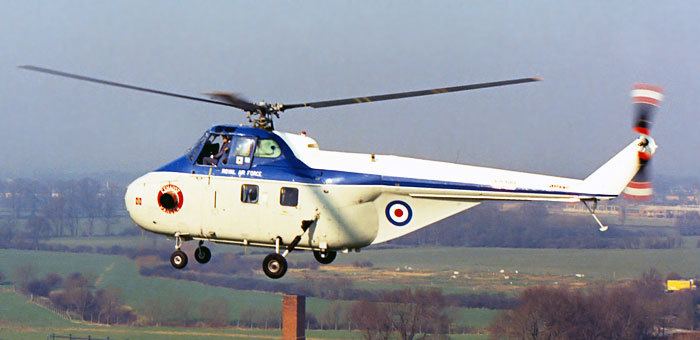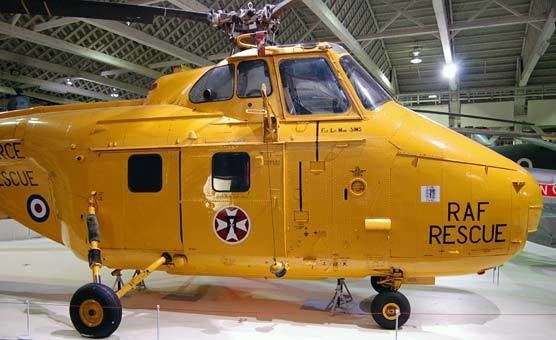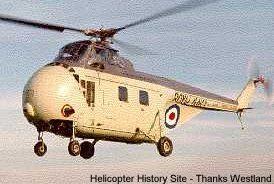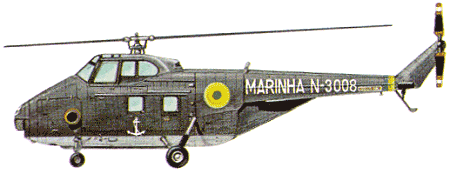Length 13 m First flight August 1953 Number of seats 2 | Introduced 1954 | |
The Westland Whirlwind helicopter was a British licence-built version of the U.S. Sikorsky S-55/H-19 Chickasaw. It primarily served with the Royal Navy's Fleet Air Arm in anti-submarine and search and rescue roles.
Contents
- Design and development
- Operational service
- Variants
- Military operators
- Civil Operators
- Survivors
- Specifications Whirlwind HAS7
- References

Design and development

In 1950, Westland Aircraft, already building the American Sikorsky S-51 under license as the Westland Dragonfly, purchased the rights to manufacture and sell Sikorsky's larger Sikorsky S-55 helicopter. While a Sikorsky-built pattern aircraft was flown by Westland in June 1951, converting the design to meet British standards (including the provision of a revised main-rotor gearbox), was time consuming, and the first prototype British aircraft, registered G-AMJT, powered by the 600 hp Pratt & Whitney R-1340-40 Wasp did not fly until August 1953. This was followed by ten Whirlwind HAR.1s, which entered service shortly afterwards. They served in non-combat roles, including search and rescue and communications functions. The HAR.3 had a larger 700 hp Wright R-1300-3 Cyclone 7 engine.
The performance of early versions was limited by the power of the American Wasp or Cyclone engines, and in 1955, the HAR.5, powered by an uprated engine, the Alvis Leonides Major, flew for the first time. This was followed by the similarly powered HAS.7, which became the first British helicopter designed for anti-submarine warfare in the front-line when it entered service in 1957. It could either be equipped with a dipping Sonar for submarine detection or carry a torpedo, but could not carry both simultaneously, so sonar equipped "Hunters" were used to direct torpedo armed "Killers". The HAS.7 was powered by a 750 hp (560 kW) Alvis Leonides Major 755/1 radial engine. It had a hovering ceiling at 9,400 ft (2,900 m) and a range of 334 miles at 86 mph. In 1960 Westland introduced a Whirlwind powered by the 1,000 hp Bristol Siddeley Gnome turboshaft, the greater power giving much improved performance over the earlier piston-engined variants. The Gnome featured an early computer controlled fuel system that removed variations in engine power and made for much easier handling by the pilot.
Later in their service lives, some HAS.7s were converted to use the Gnome turboshaft engine, as the HAR.9.

After entering service with the Royal Navy, the Whirlwind came to be used by the British Army and Royal Air Force. More than 400 Whirlwinds were built, of which nearly 100 were exported to foreign customers. The French Navy received 37 Whirlwind HAR.2 between 1954 and 1957.

Whirlwinds, painted in overall yellow, were used by the RAF Search and Rescue Force for rescuing people in distress around the coast of the UK, before later being replaced/supplemented by first the Westland Wessex and later, the Westland Sea King.
Operational service
848 Naval Air Squadron of the Royal Navy's Fleet Air Arm was the first squadron to HAR.1's which replaced the Sikorsky built HAR.21's for utility and Search and Rescue from July 1954.
Variants
The model numbers for the US-built evaluation models were
Military operators
Civil Operators
Survivors
Over 69 aircraft remain in private ownership, dumped or in museums including the RAF Museum and the Fleet Air Arm Museum as well as being the current gate guardian at RAF Odiham.
Specifications (Whirlwind HAS.7)
Data from Westland Aircraft since 1915
General characteristics
Performance
Armament
